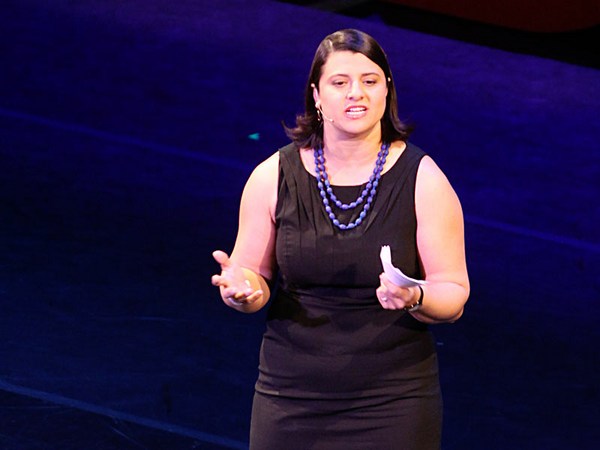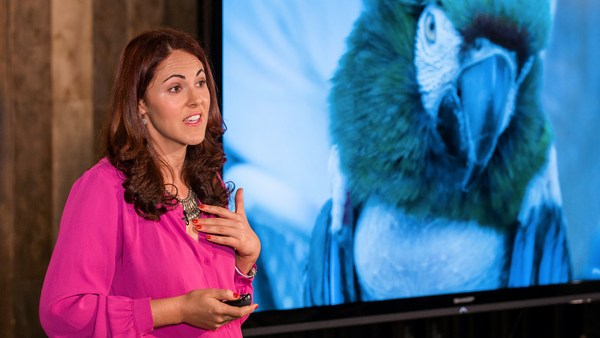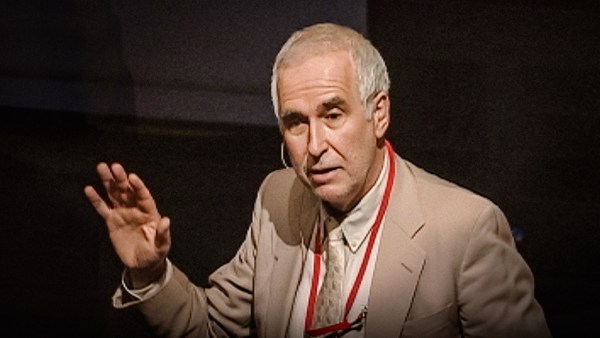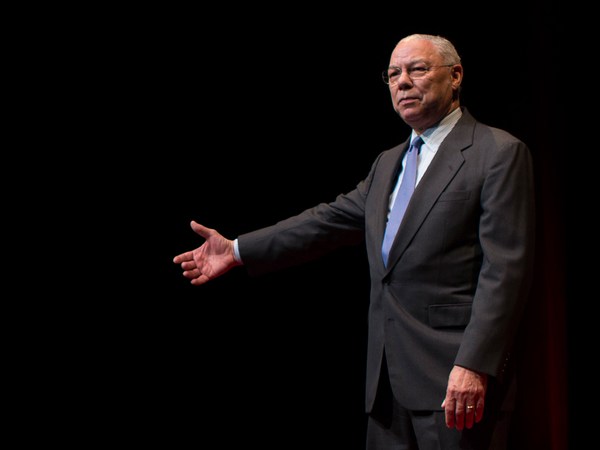(Directing Bailey in English) Hello, everyone. My name is Yuko Morita. This is a facility dog, Bailey. When you were a kid, were you afraid of getting shots? When you were getting a flu shot at school, you probably asked your friends, 'Did it hurt? Did it hurt?' As you know, kids are very afraid of injections or having their blood drawn. Hospitalised children have to have their blood drawn so many times. Some kids need bone-marrow aspirations by drilling a thick needle into their spine. This dog, Bailey has the magical power to make these kids say: 'If Bailey is with me, I would put up with it 100 more times'. He is such a competent dog. The Japanese medical level is said to be top-notch, for curing diseases. But in Japan, while 'to be patient' has been considered a virtue, it is said that the quality of hospitalised life is poorly supported. I used to work as a registered nurse at a children's hospital in Tokyo. One day a mother of a hospitalised kid said, 'This is almost like being in jail'. I was thinking that I was working very hard for the children, and I was very shocked to hear that. In fact, kids in the hospital are not supposed to go out even for a walk. They are not allowed to have their favourite foods. They barely have fun. Some kids stop smiling. When I think back about it, it might as well be called a jail. At that time, I was with an NPO called 'Shine On! Kids' and they offered to let me become a handler of a service dog. The Non-Profit Organisation was founded to emotionally support kids and their families who are suffering from childhood cancer and other incurable diseases. At that time, I only knew that a dog is taken to a children's hospital and the dog works as a member of the medical staff -- there were a number of facility dogs working in Europe and the US, yet obiously none in Japan; that was all I knew about facility dogs. I thought 'If a service dog were working in this ward, the children's hospital life, once called a jail, would be way happier', and I was excited to think so. Without hesitation I said, 'Yes, I would love to'. There is no training institutions for facility dog program in Japan. Both Bailey and I were trained at a Hawaiian training centre. In a children's hospital in Hawaii, we also practiced following around our senior facility dog and their handler. To my surprise, the service dog went into the ICU. The intensive-care unit is where seriously ill patients are taken care of. There was a child who had just gotten out of surgery with their head half-shaven, and a large scar on their head. The kid was frowing painfully. To my great concern, 'Is it really OK to go there in such a serious situation?' the facility dog went in there, and climbed on the bed right beside the kid laying with the tubes around them, and went to sleep alongside the kid. Then the kid grew relaxed. In spite of all the pain of moving, the kid hugged the dog and closed their eyes. The kid looked so calm and easy. At the sight of it, I thought ’WOW, that's cool!’ Being excited about making all the hospital wards full of smiles, I came back to Japan with Bailey. However, facility dogs are totally unprecedented in Japan. The Western mindset for dogs is totally different from that of Japan. In Europe and the US, it's been quite normal to have dogs in the house as family members. On the other hand, in Japan, we have a history of having them outside. It is outrageous to have a dog inside the hospital ward: that was what Japanese hospitals thought. Before us, sometimes there were dogs volunteered to visit hospitals in Japan. But there was not a precedent of having a dog in hospital everyday, and considering dogs as a medical staff. What was right in Hawaii was far from right in Japan. We desperately looked for a hospital that could accept Bailey as a staff. Then eventually we were accepted by the Shizuoka Children's Hospital. But the reality was that people said; 'Can't the dog be replaced with a dog robot?' or 'To protect kids against infections, do not enter this ward'. At first we could enter only one ward. So one-day of rounds was finished in a few minutes. We got to the workplace and an hour later, it was time to go home. 'I don't think Japanese culture is going to make people want to adopt a facility dog programme', I could only think in a negative way. But in fact, children needed Bailey. Five years have passed, and now we are accepted by almost all wards. Bailey brings about positive differences to both kids and their families', -- that was what doctors and nurses started to notice. There was a child who was visually impaired and was always screaming in panic when they had their blood collected. But with Bailey by their side, they were distracted by petting Bailey on the head, the kid could go through blood tests without crying. Another kid who wouldn’t move at all due to pain after surgery suddenly got up just because they wanted to see Bailey. That was a big surprise to the doctor. A family, who are suddenly told that their child has cancer, will pretend as if nothing happening to prevent their kid from being nervous. But people cannot suppress their feelings for good. Sometimes it is important to cry. With somebody who is human, they would feel a need 'to say something'. But to Bailey, they never have to say anything if they do not want to. I saw a mother in a hospital corridor, after hugging Bailey, crying as she wanted and with a relaxed expression, she went back to her kid's bed. Bailey was a positive influence for their families, too. Then I found there are three important bonds for a facility dog. One is a bond between Bailey and the kids, another is Bailey and his handler, and the other is Bailey and the medical staff. These are three important bonds with Bailey. The first bond is: as Bailey works at the same hospital everyday, he sees the same children many times. For children, just having a dog is not good enough. Bailey, who comes to them everyday, really matters. Only with Bailey who has bonds with the kids, can they be courageous enough to hang in there. Even with a dog phobia, almost all kids will come to like Bailey eventually. For kids, Bailey is a teammate with a tail who fight against their illness. Bailey can even enter the surgical theatre with a child. Even an adult is scared of getting an operation, right? Wondering 'Does it hurt?', or feeling scared, they have to spend the terrifying time from the ward to the theatre. But holding Bailey's leash, walking with him, children can guide Bailey smiling and walking to the theatre. It is a privilege walk with everyone's favourite Bailey, without anyone else! Some kids walk playfully around Bailey's fluffy tail as if they are cats. Some kids say smiling, 'Bailey's wagging his tail means Good Luck'. In this way, scary feelings turn to exciting feelings; which encourages kids to go to the theatre.
The second bond is: between a facility dog and their hander, who live together twenty-four seven. We always spend holidays together too. This is very important; just getting together while working and saying 'Bye-Bye' after five doesn't make any sense. We sleep at night and Bailey sleeps with his head on my arm. The bond between a facility dog and their handler is the basis on which a facility dog works professionally. Only the bond with me can convince Bailey to trust me to work together. But the truth is; you may think that a training dog will do anything I say, Bailey is a stubborn guy who goes only where he wants. To a direction he doesn't to want to go, he does like this. Can you see he is hanging on with all his might? Planting his feet firmly on the ground, digging his nails into it, he never goes where he doesn't want to. While walking on the street, I sometimes struggle with Bailey sitting there. People passing by always say laughing, 'That's troublesome'. But he has never refused to go to the hospital. On the contrary, he sometimes refuses to go home, squatting there, going back into the hospital ward. Dogs easily understand what people are thinking about them. Because there are many people who love him, Bailey loves the hospital very much. Both a dog and people are mutually affected; that is where the facility dog belongs. This is why non-sentient toy dogs cannot make this happen. A robot dog can not make this happen. The third bond is between Bailey and the medical staff. The handler of a facility dog is a medical staff. The reason why only medical staff can be a handler of a facility dog is: that a facility dog's work includes not only healing mentally, but also curing physically. Bailey and I sometimes take a part in the conversations where treatment courses of patients are decided. I also figure out how our patient kids are and work out how to approach this patient. I also write on the medical charts. In this way, to be involved with specific purpose is what only facility dogs are capable of, and why a handler of a facility dog must be certified medical staff. It has been five years since Bailey and I started working in Japan. We have met thousands of children. We once met a kid in the terminal phase of disease and the kid could not eat. He wanted to but he couldn't eat; that was his situation. Given a short span of time, both his family and nurses wished that he could enjoy whatever little amount of food he could. Then there was a suggestion made Bailey attended at his dinner table. With Bailey, the kid was happy to sit up smiling. Saying, 'Bailey, look at me', though it was only a few mouthful, but he could managed to grab spaghetti into his mouth. He could also enjoy ice cream, not being forced to do so, but willingly to do so. Only the presence of Bailey bedside could make that level of change. The bad impression of a hospital changed so much as to make children say, 'I want to be hospitalised to see Bailey'. With Bailey, kids can double their fun. With Bailey, kids can share tears and fears. Most children are discharged from hospital safe and sound. But sadly, some kids have to leave this world forever, and Bailey sometimes sleeps with them till just before their last moments. We say 'You know, Bailey's with you', 'It's warm, isn't?' to kids. The time goes on sadly but warmly. We sometimes attend a funeral for children. When parents have to close the lid of their own child's coffin, can you imagine how they feel? In fact every family says 'We were really happy to have Bailey with us'. They always say that. 'Before Bailey, the hospital stay had been just so heart-wrenching'. 'With Bailey our kid's life changed so much'. These are what bereaved families said to us. A family who lost their child will reflect on their child everyday, through their long span of life. Remembering their child as 'a poor soul who went through so many painful operations; or remembering their child as 'a laughing kid sleeping with Bailey just before death; their feelings are completely different, aren't they? We wish to make a small portion of happiness in their heartbreaking memory. We wish the bereaved family remember as many smiles of their kid as possible. The Facility Dog Programme is not an option, but necessity for hospital care, that's what I strongly feel about it. Japan's medical care is said to be the highest in the world. Not just curing disease, but also having an environment for healing disease more proactively is necessary, I think. For patients, they can't have too much fun. There are a lot of facility dogs in Europe and the US, but in Japan we have only two. I would like to have facility dogs as a standard in Japanese hospitals and make Japanese hospitals a fun place to be in, even for patients who have medical conditions. So many children who passed away are watching for us from heaven. For those kids, I would like to make the Japanese medical front a place where I can be proud to say, 'Hey, it's a good hospital, isn't it?' (Applause)





